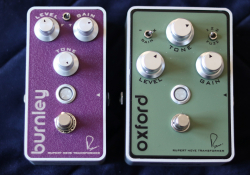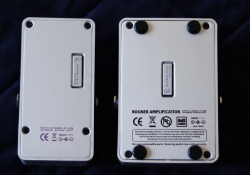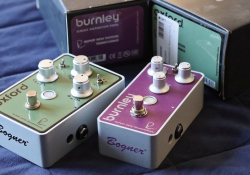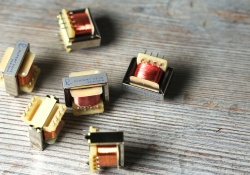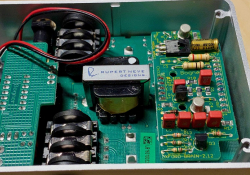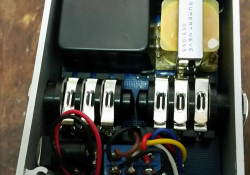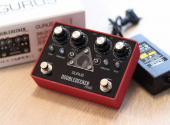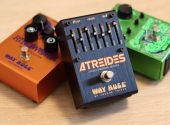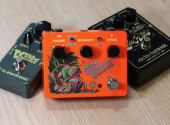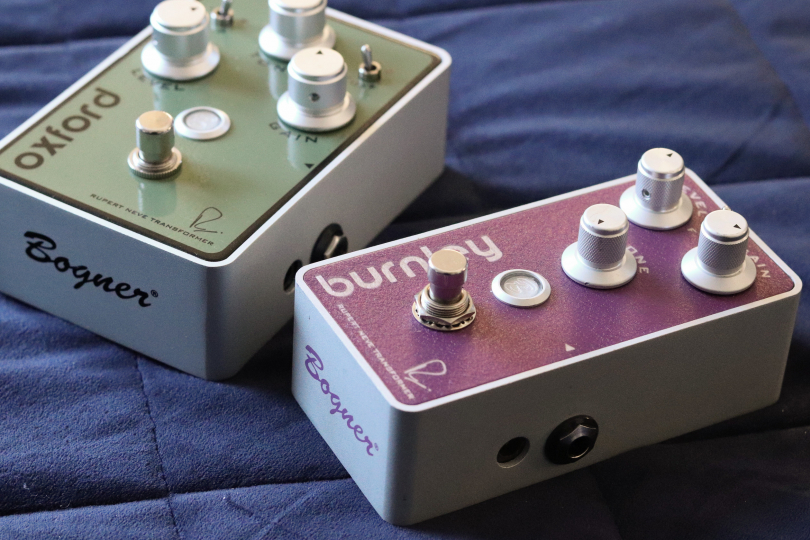
Pedalboard Gems #14: Bogner Neve Transformer
In the eighth part of the Gem series, I promised to take a closer look at Reinhold Bogner's collaboration with the now sadly departed audio legend, Rupert Neve. Mainly because it resulted in another very unconventional and innovative design in guitar effects—the award-winning Transformer series.
A high-end guitar amplifier needs high-quality, big and heavy transformers. And, talking about the affordable models, a transformer is also the first component on which the managers skimp. Bogner had his typically crazy idea to add a high-quality miniature transformer to the pedal to improve its sonic qualities. And because he's always been thinking big in his furry hat, he approached the most trusted persona in the world of sound, Rupert Neve, to collaborate with him and design exclusive mini transformers tuned for a specific Bogner effect.
Gradually, a whole series, called Transformer for short, was created, and Bogner, as usually, then tuned their design in incremental steps—as he describes in the advertising texts—to provide customers with a fat, rich sound, ultra-dynamic response and unprecedented three-dimensional sound quality inspired by the iconic mixers of the 1960s. While the larger flagship compressor and fuzz were first introduced in smaller stompboxes, the more complex topology seems to have necessitated current larger versions.
New sonic possibilities thanks to the ferrosilicon combination
The Oxford is a fuzz pedal with a non-traditional army green faceplate combined with extruded aluminium. And it wouldn't be a Bogner not to bring something new to this otherwise already bustling segment. The most commonly known fuzzes are germanium and silicon, very simplistically: Ge for fat and Si for sharp sound. The Oxford is called FeSi (Ferro Silicon). Besides its admired fat sound, germanium is, in fact, also known for its thermal instability, so Reinhold retook the untrodden path to avoid these thermal complications and offered an unconventional construction on a different basis (while, of course, GeSi combinations are pretty common). The result is a fuzz with huge possibilities: from subtly dynamic distortion to crackling squealing fuzz inferno... and everything in between.
Oxford Fuzz and its features
The three classic Level, Tone, Gain controls are complemented by a -/+ gain switch that, combined with the large Gain, dramatically changes the range of distortion from a really subtle one with a hint of fuzziness to wild fuzz higain. In fact, in the very first version introduced at Musikmesse 2013 (at that time without Rupert Neve's name), the Oxford was still called Flexidrive. After its redesign as the Oxford Fuzz, this flexible behaviour between fuzz and overdrive not only remained but was enhanced.
A three-position Fuzz Z/Z/Z switch (positions: darker, dark and bright with more attack) is used for detailed fine-tuning. This is really needed because the interaction between the knobs is significant and changes in gain impact the frequency response. The sharpness or amount of bass is constantly being fine-tuned with the Tone pot. The guitar response to the volume pot is excellent, as we know from quality germanium fuzz pedals. It thus becomes another means of playing expression. A soft click footswitch with relatively strong resistance (just suitable for the foot) is another proof of quality.
I was a bit puzzled by the warning sign on the back cover saying that opening the pedal could compromise the warranty—and I wondered how to replace the battery then :) By the way, the battery is also Bogner—Reinhold just thinks of every marketing detail. To quote the conclusion of another in-depth review, the Oxford is a perfect starter fuzz pedal for people who don't like fuzz. Simply fuzztastic!
Transformer and associated series
The Lyndhurst compressor currently complements the large Transformer line. The Nordic-tinged name might desirably suggest a Scandinavian quality, except that it's Old English and cites geographically important British locations from Rupert Neve's life as an expression of respect.
The minor series is thus made up of Harlow, Wessex and Burnley. Buffer/Boost/Splitter called Zero is no longer available. Harlow is an attractive booster coupled with a compressor. In the words of Reinhold himself, "If you like compressors, you'll love this one. And if you don't, you will." :) The Wessex is a dynamic low gain overdrive, and the Burnley a full-bodied distortion. I couldn't show you the excellent demo by well-known YouTube tester Burgerman, where he shows the Burnley in his crazy yet stylish furry hat, so check out the visually somewhat psychedelic but sonically excellent and fantastically played demo by Sam Vilo instead.
Although I'm personally not a big fan of distortion pedals, I'll take the liberty of paraphrasing previous marketing statements—Bogner Burnley is a distortion pedal for those who don't like distortion :) Again, the three classic Level, Tone, Gain knobs are complemented by the F/T (Fat/Tight) switch for fat solos or clearer accompaniments (but its specific use is, of course, up to you). I was pleasantly surprised by its rich, ear-pleasing higain with excellent response to pick dynamics. The sound changes noticeably according to the strength of the strike, which is further supported visually by a large led light (called the Jewel Light), changing its brightness and colour according to the strength of the signal. As I describe it, it may look strange; still, I applaud the brand marketing department because the light perfectly confirms the players' feelings that the effect dynamically responds to their play.
According to Reinhold, this 3D organic liveliness, sound with soul and buttery feeling is caused by the non-linear behaviour of the Neve transformer. When explaining it in more detail in his furry hat, he used terms like frequency response versus hysteresis and signal saturation (which I didn't quite pick up due to my poor electrical engineering knowledge).
For me, the sensations I experienced during the testing did nicely—and I recommend everyone to try their receptors (far from just auditory). Meanwhile, as Frontman keeps informing you, the smaller series is offered in an even smaller V2 version—but it lacks the clever opening to see the transformer, which I loved so much. Of course, I understand their pragmatic decision about production costs, but from a marketing point of view, the inscription alone is a significantly weaker message than turning the box and seeing the little magic transformer in the opening with your own eyes.
The range is rounded off by deluxe versions with hand-cut and polished exotic Bubinga wood faceplates for those who feel like getting a little more warmth into the sound, thanks to the wood. Because for us, guitarists, it's all about feelings.
If you have found an error or typo in the article, please let us know by e-mail info@insounder.org.

